IMG Heavy Transport
This article has not been verified to be up to date for the latest version of the Discovery mod. The last edit was made on 22.10.2017 (DD/MM/YYYY). You may help by updating it, often by using the code generator.
| IMGT-8C "Shishapangma" Heavy Transport | |
| Ship Class | Transport |
| Built by | Independent Miners Guild |
| Technical information | |
| Guns/Turrets | 0 / 10 |
| Opt. weapon class | 3 |
| Max. weapon class | 3 |
| Other equipment | None |
| Hull strength | 161,500 |
| Max. shield class | 6 |
| Cargo space | 4,300 units |
| Nanobots/Batteries | 500/500 |
| Max. impulse speed | 90 m/s |
| Max. thrust speed | 150 m/s |
| Max. cruise speed | 350 m/s |
| Power output | 90,000 u |
| Power recharge | 7,500 u/s |
| Additional information | |
| Ship price | $95,000,000 |
| Package price | $95,600,500 |
Unlike most House corporations, the Independent Miners Guild favors mining operations far from the existing network of trade lanes and jumpgates. As IMG exploration vessels pushed out further, the Guild realised it needed a large cargo vessel capable of both bridging long distances in open space, be capable of travelling through dense asteroid fields, yet still have a large enough cargo bay to be able to carry both various types of cargo.
The Shishapangma heavy transport was designed from the ground up for this task. It features a large crew section in the nose of the ship, allowing it to carry anywhere from 50 up to 250 crew, with an emergency evacuation capacity of 1000. Supply storage pods in the bridge section allow the vessel to operate autonomously for up to 4 months with a standard crew. Strong navigational scanners mounted on the top and bottom of the bridge section allow the vessel to navigate asteroid fields without risking severe damage. In addition, the entire ship is also heavily reinforced against collisions. It's point defenses consist of 12 turrets mounted on the cargopod support struts, offering good all-round coverage. 7 standard civil transport engines provide adequate thrust for the ship, as well as redundancy in case of an engine failure.
Cargo is stored in three huge hexagonal pods, which can be seperated from the ship for a quick turn-around. The pod bay doors slide inward for easy access to the interior, which allows components almost as large as the ship's length to be stored within. While generally used for bulk transport, the interior of the cargo pods can be configured for piece goods or container freight. The cargopod interior is generally not pressurized and does not have life support capabilities.
Handling
- This ship is too large to use docking bays, it must use mooring points.
Hardpoints
Purchase Includes
| Spoiler: |
|---|
|
Availability
| Spoiler: Buying Locations | ||||||||||||
|---|---|---|---|---|---|---|---|---|---|---|---|---|
|
